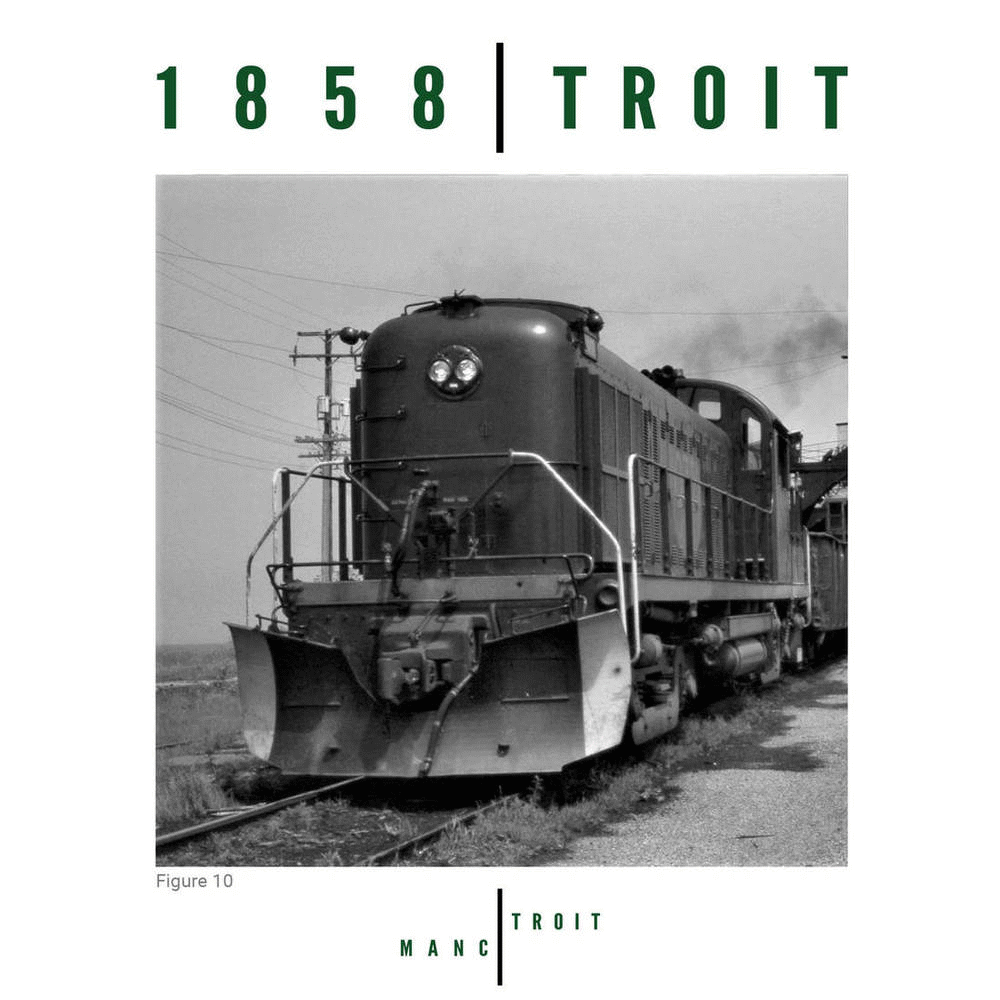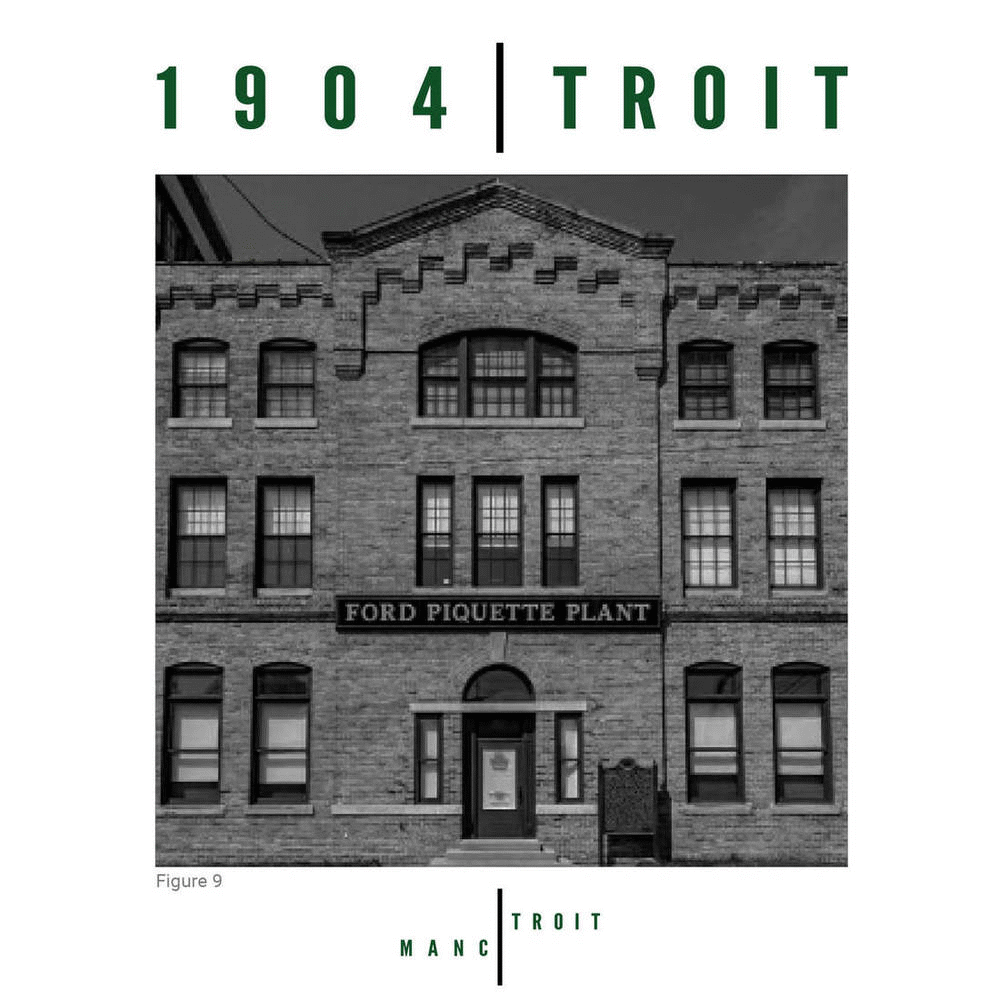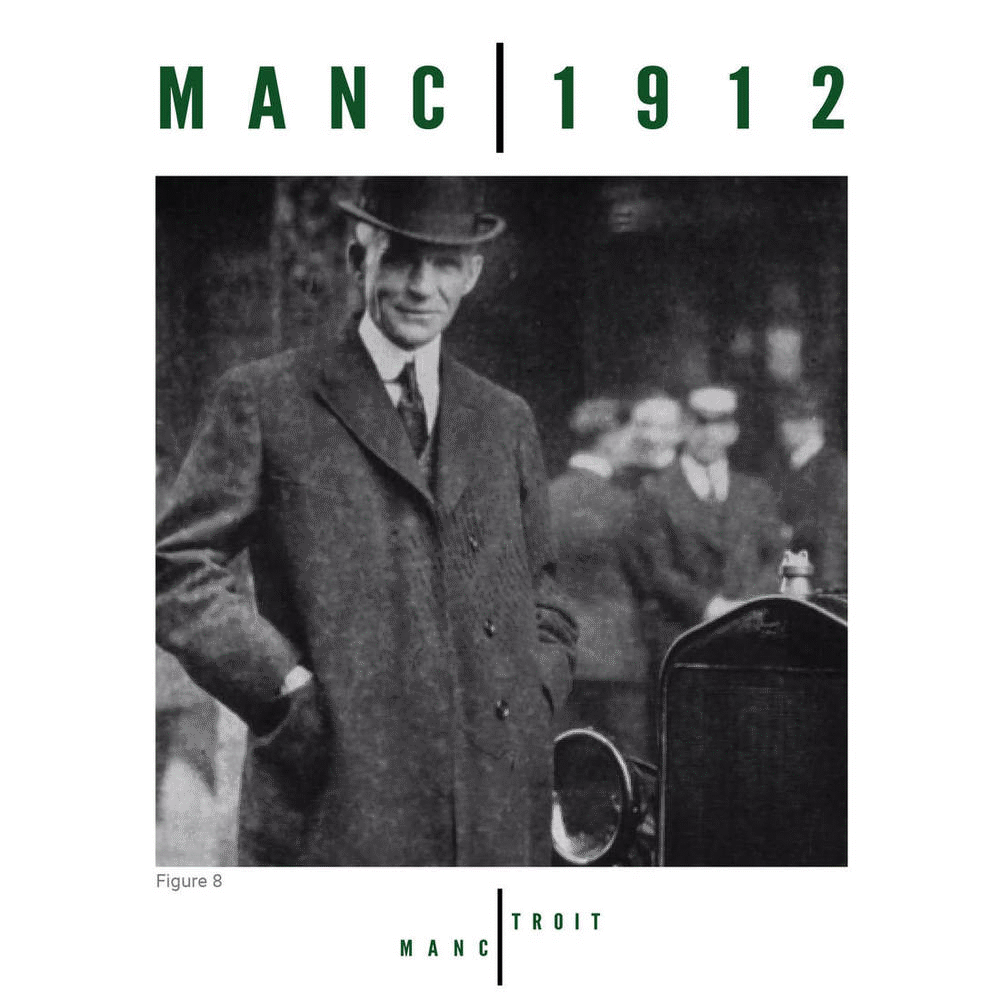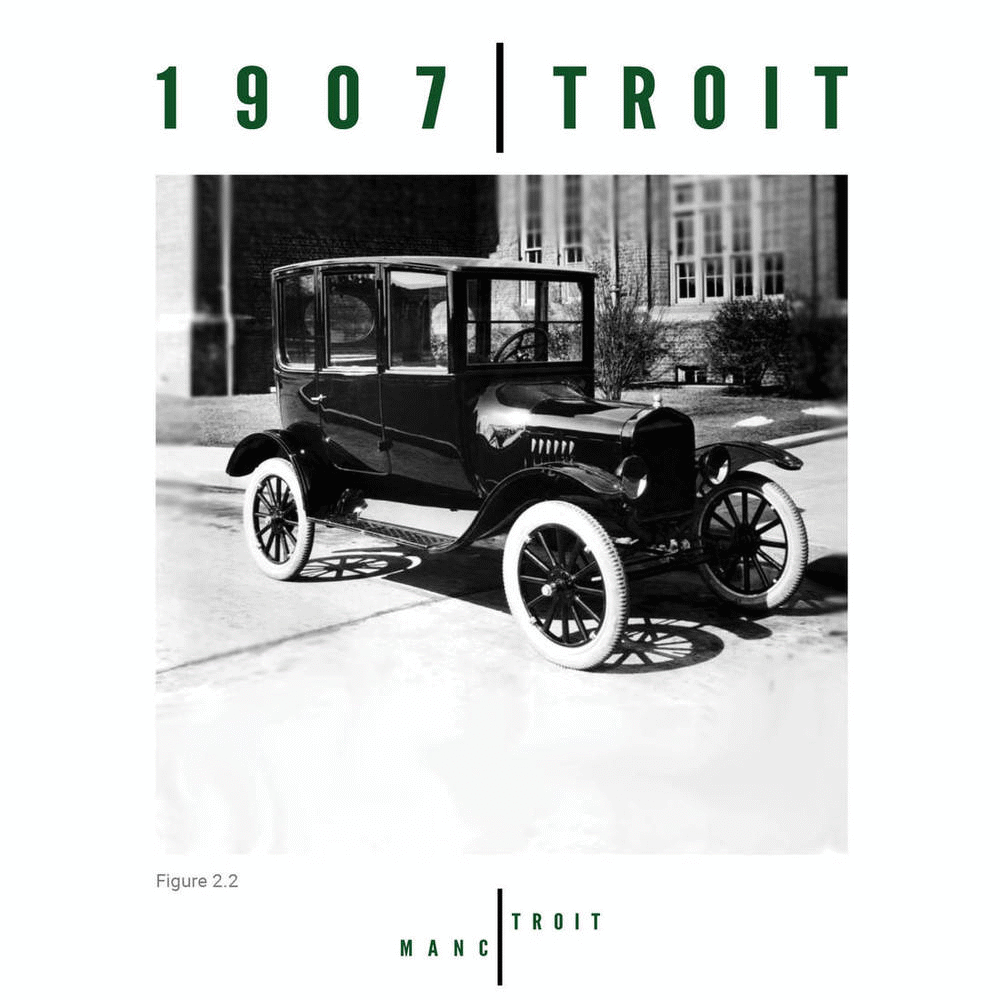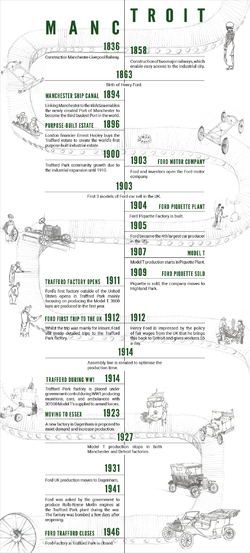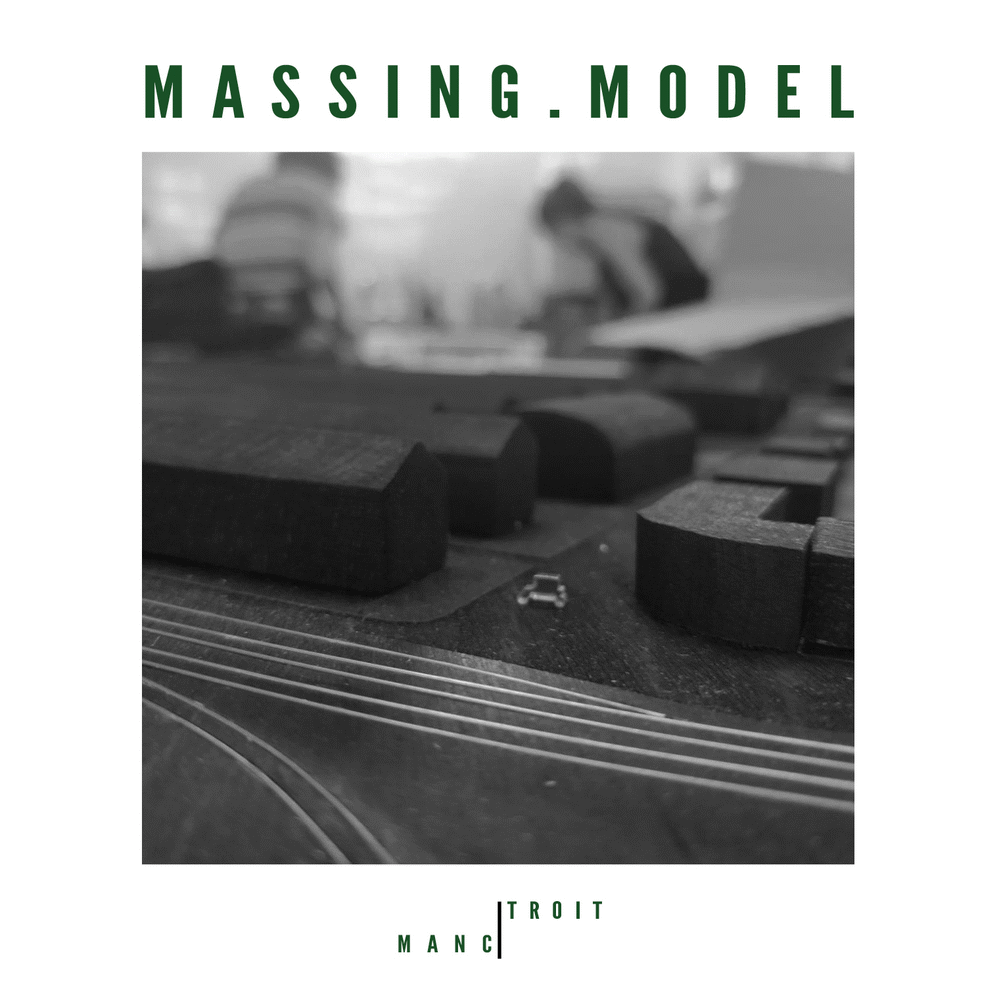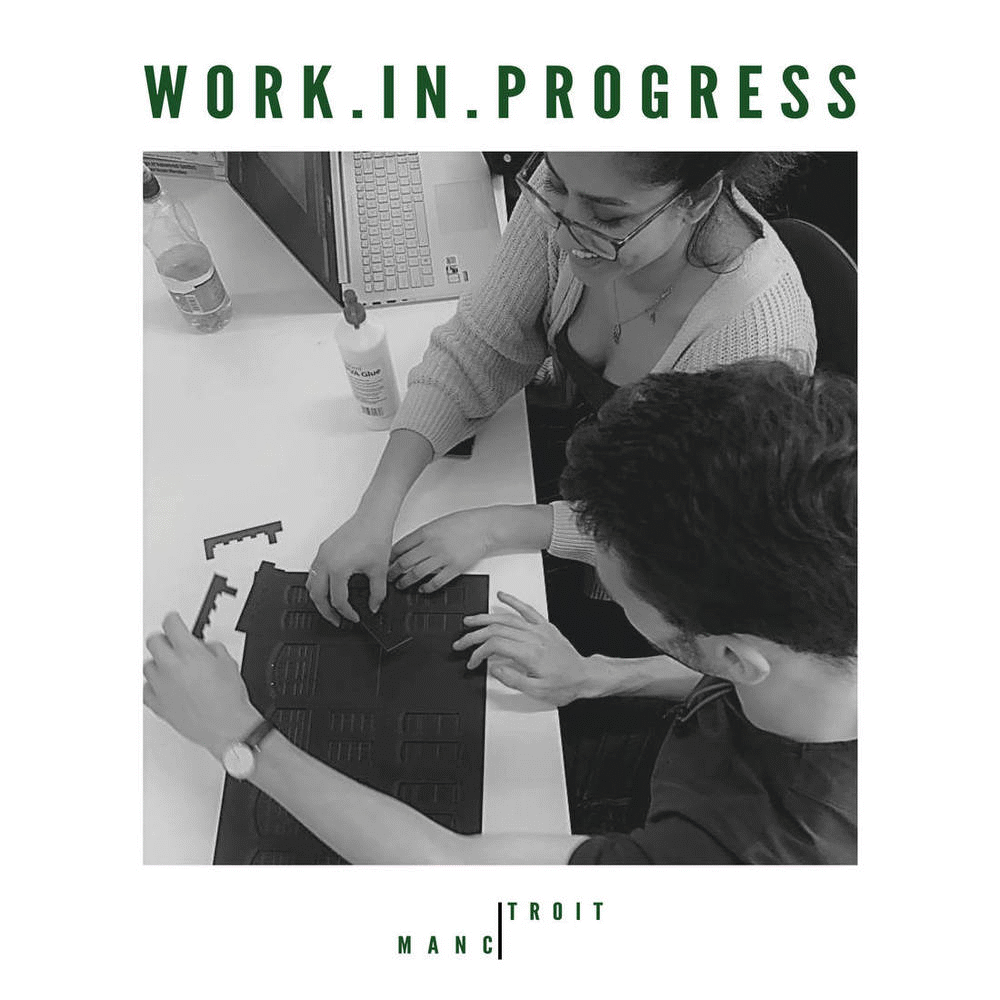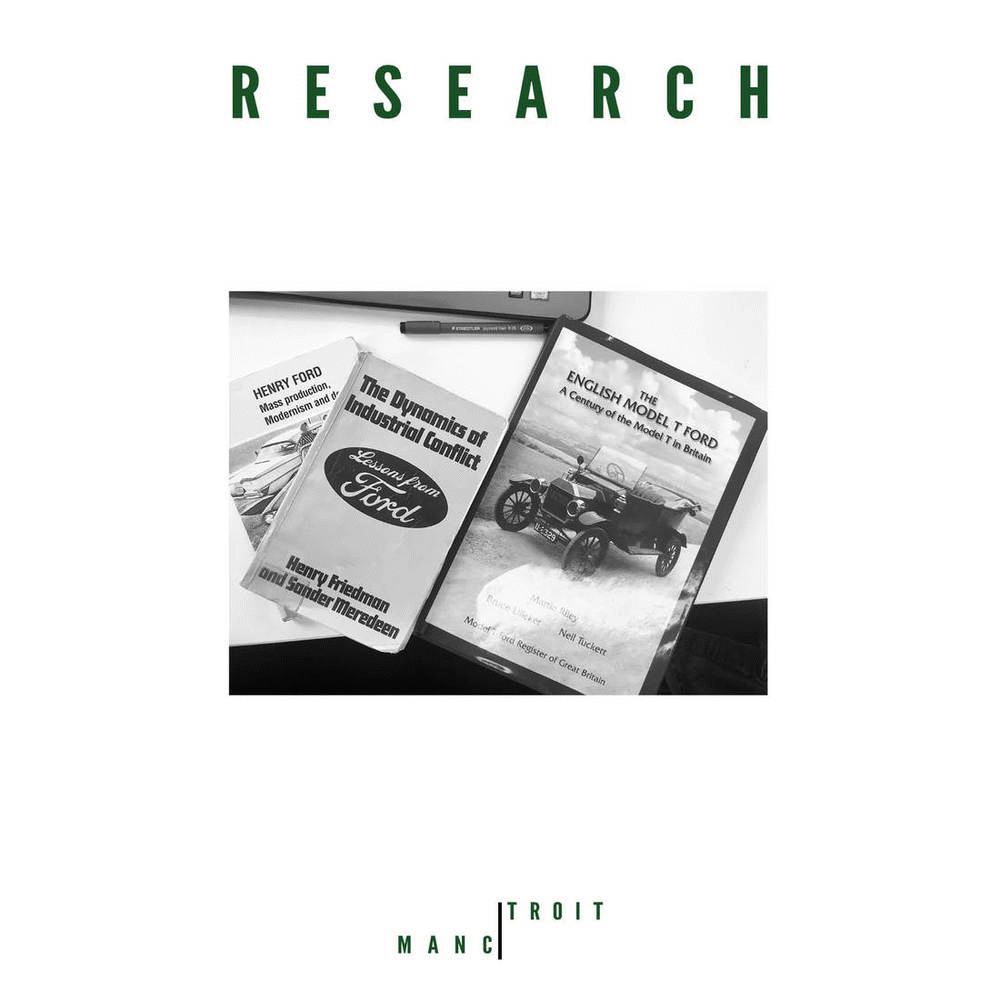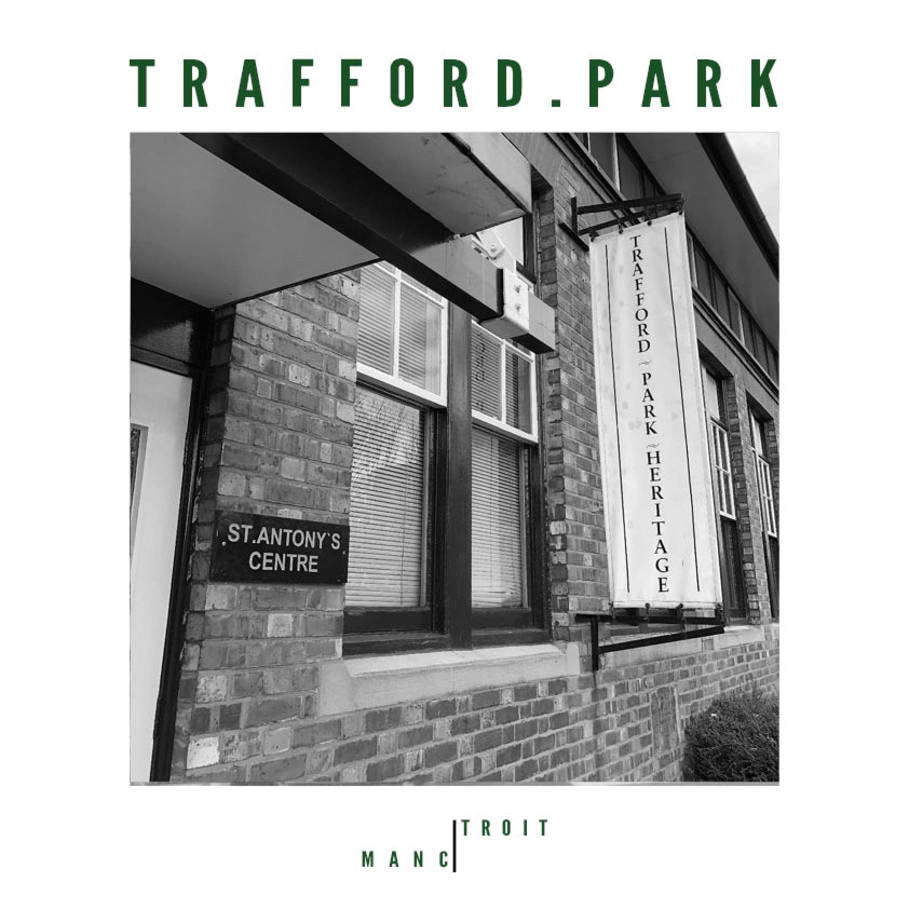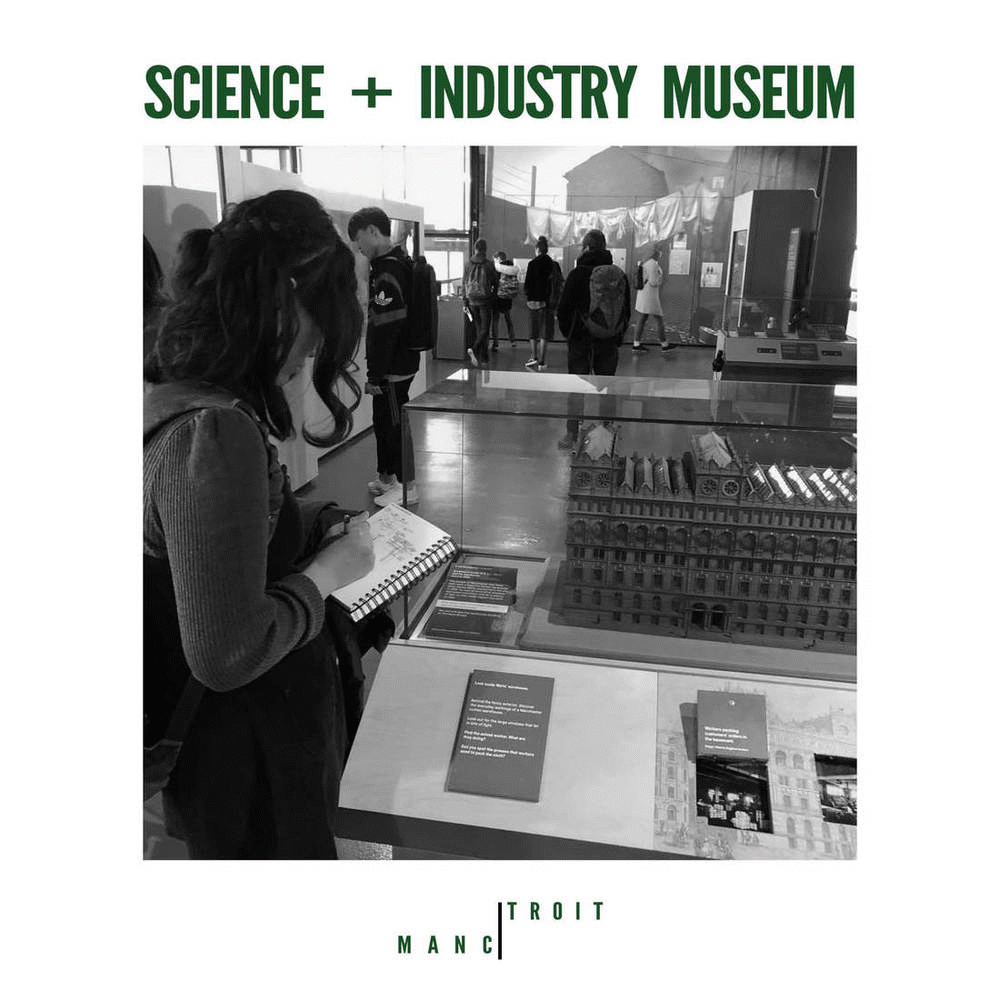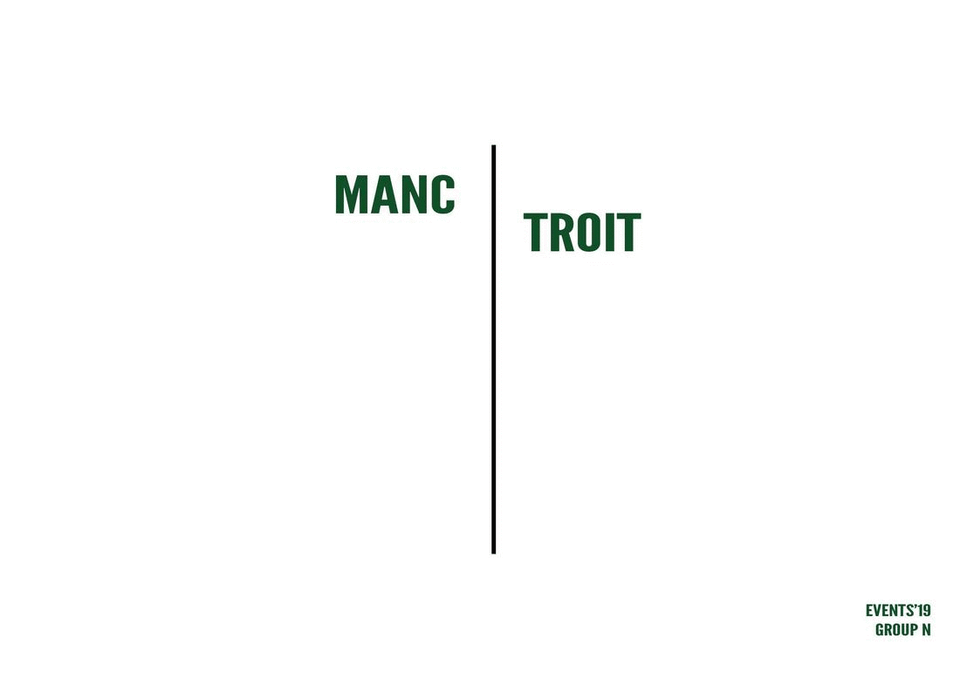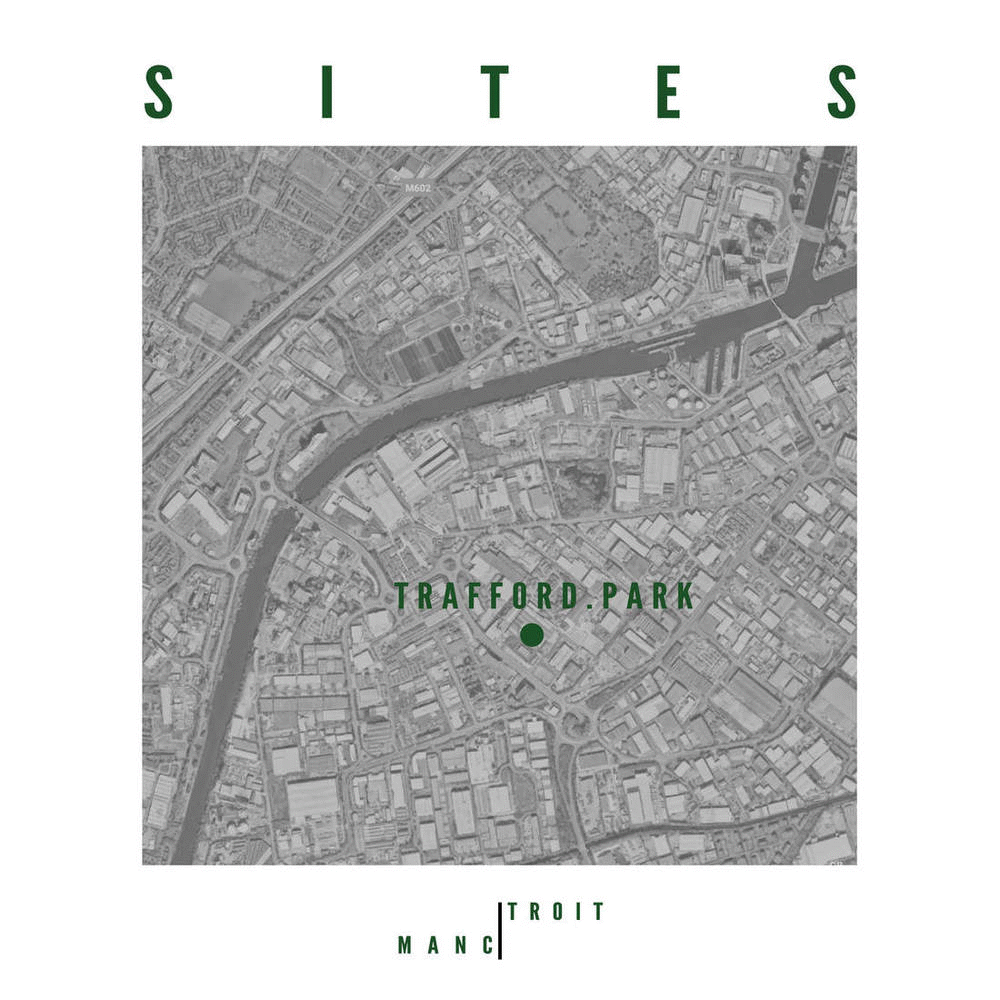DAY 10
The final day marked the end of the 2 week events project. We were able to practice our presentations in the morning and also ensure the model was all ready to go. We presented to our collaborators from the Science and Industry Museum, Dominic Sager as well as Kevin from the St Anthonys centre in Trafford; a small heritage centre in trafford park! The presentations were a success and all collaborators were thoroughly impressed with the level of detail shown in the models, as well as the information provided to them. We aim to donate the exhibition piece to the St Anthonys Centre in June, where Kevin hopes to display it and invite local historians too view it too! Katie was impressed with the quality of work and has gone away with ideas for the museum! To conclude the project, we have worked towards our original brief of 'how can we tell a story through model making' with particular attention to Henry ford, his journey to Manchester and the much loved Model T!
Posted 6 Apr 2019 20:59
FINAL OUTPUT
We were finally able to put all of our hard work together into a coherent exhibition piece. To the right we have the 1:50 model of the Piquette plant in detroit from 1905. In the middle we have displayed the timeline, documenting the history of Henry Ford and his journey to Manchester and ultimately this journey ends on the left with the Ford factory in Manchester (modelled from 1926!) (Manc Left, Troit Right!) The post cards correlate to key dates from the timeline and give the audience a more thorough insight into that particular date or event!
Posted 6 Apr 2019 20:52
FINAL OUTPUT
POSTCARD 10
The final postcard is bibliography of our research and list of figures documented by all the students.
Posted 5 Apr 2019 11:19
FINAL OUTPUT
POSTCARD 9
Detroit started to transport products by water in 1818 from the UK and USA. Products were transported by water or rail. In 1858 two railway lines were created in Detroit, which made the city an attractive location for manufacturers, as it had an easy access in order to export products to other parts of the country. It was after the American Civil War (1861-1865) when Detroit clearly became an industrial city. For these infrastructural connections, Detroit became the perfect spot for Henry Ford to open the factory. Very soon, Detroit became the world’s capital for the automobile production. (FordPiquettePlant, 2019)
Posted 5 Apr 2019 11:16
FINAL OUTPUT
POSTCARD 8
The Ford Piquette Plant was Henry Ford’s first car production factory, it oversaw the production of Ford models B, C, F, K, N, R, S, and T during its service. The building was a total of 3.11 acres, covering an entire city block and was located strategically next to the Michigan Central Railroad (Ford Piquette Avenue Plant, n.d.). It consisted of three storeys: the ground floor housed a machine shop, the shipping department and was used to test cars; the first floor was focused on assembly and storage; and the second, oversaw drafting, and final assembly of all vehicles. The Ford Motor Company’s presence in the plant ended in 1910 as it moved to the larger Highland Park Plant, selling the Piquette to automobile manufacturer, Studebaker in 1911. (Fordmotorhistory.com, n.d.)
Posted 5 Apr 2019 11:15
FINAL OUTPUT
POSTCARD 7
The Ford Motor company expanded its facilities to Trafford Park by purchasing a large low-cost site to grow the business. Henry Ford also saw the opportunities to stay in the fast line against competitors after being attracted to the great pool of skilled engineers in Manchester and the railway and canal connections to Detroit, creating an easy flow of shipments of components between the two factories. Manchester was the ideal place for the assemblage of The Model T cars, gaining a reputation in the British and European markets.
Posted 5 Apr 2019 11:14
FINAL OUTPUT
POSTCARD 6
During Ford’s trip to the UK he was impressed by the talented entrepreneur Percival Perry and his policy of fair wages. Perry was the company’s chairman who opened Ford’s first factory outside of North America in Great Britain. Ford was suprised by the British workers and their eagerness to work, surpassing their American counterparts in terms of productivity on the assembly line. On his return to America in 1914, Ford offered a daily $5 wage, doubling the rate of most of his workers. This proved to be a huge success. Instead of the constant turnover of employees, Ford created a stable workforce while streamlining the production process. The best mechanics in Detroit gathered at Ford, providing their expertise, raising productivity, and lowering training costs paving the way for modern mass production.
Posted 5 Apr 2019 11:13
FINAL OUTPUT
POSTCARD 5
The world’s first industrial estate, Trafford Industrial Park, first appeared on the map in the mid-1800s as 5 square miles of deer park and woodland (Herron, 2015). However, with the rapid industrial growth in Manchester, along with the completion of the Manchester Ship Canal in 1894; the land became high demand for potential industrial space and in 1986, London-based financier Ernst Terah Hooley purchased the land to do just that (Herron, 2015). Prior to Fotrd’s association to the park, the Westinghouse Electric Company was the first American company to open a factory in Trafford Park and in doing so, introduced an American style grid street layout that accommodated for workers families (Boardman, date unknown). This can still be seen in the park today.
Posted 5 Apr 2019 11:12
FINAL OUTPUT
POSTCARD 4
In the year 1911 the Ford assembly plant was the first factory to be built outside of the USA. (Friedman and Meredeen, 1980) The production of the Model T was established in Trafford Park, an industrialised region near Manchester since it had the canal connections for importation. The Ford Motor company employed over 50 people to work on the first mass produced car through repetitive labour and in the first year about 3000 cars (Ford of Britain: Yesterday today.., 1968, pp.52-54) were sold at $680, equivalent to £500. (conceptcarz.com, 2019) However, the price did not attract the attention of the working class as it was targeted towards the middle-class market.
Posted 5 Apr 2019 11:11
FINAL OUTPUT
POSTCARD 3
With the introduction of the Model T in 1907, Henry Ford envisioned “motor cars for the great multitude” (HISTORY, 2009). In order to create an affordable vehicle that could cater to the masses, the Model T would need to be built more efficiently and therefore need to be produced at a cheaper cost. Ford’s incorporation of an assembly line methodology was inspired by the continuous flow production that existed in food packing factories. By reducing the construction of the Model T to 84 simple steps and training workers to do one task, the assembly line was introduced. By 1914 production time per vehicle was cut down from 12 hours to a mere 93 minutes (Goss, 2018).
Posted 5 Apr 2019 11:10
FINAL OUTPUT
POSTCARD 2.2
The introduction of the Model T in 1907 was a huge success to the Ford Motor company. Due to the efficiency and reasonable pricing of the vehicle the Model T was in high demand therefore Ford had to alter how the industry works by having an assembly line mass overseas production in Manchester in order to manufacture the cars in great quantities (Detroithistorical.org, 2019). The local workforce in Manchester was vital for production plant, they were able to double the output from 3000 cars to 6000 after one year of its opening. (Thesahb.com, 2019)
Posted 5 Apr 2019 11:07
FINAL OUTPUT
POSTCARD 2.1
Model T. The design process of the model T was run by Ford’s hand-picked team (Ford Piquette Avenue Plant, n.d.). The first complete Model T for testing was produced in 1907. The model could seat five people and performed well. It was very well received by people as a lot of orders were made months before the car went into production.
Posted 5 Apr 2019 11:06
FINAL OUTPUT
POSTCARD 1
Henry Ford was born in Michigan in 1863. He was raised on a farm and from an early age he showed great interest in mechanical objects.
He married Clara Bryant in 1888 and a few years later the couple had their one child, a son, Edsel. He worked as an engineer for an illuminating company for a few years. Before founding the Ford Motor Company in 1903, Henry Ford had set up two other companies that had failed. The Ford Motor Company was very successful as after a few years of opening it was the leading automobile company. The company is mostly known for using the moving assembly-line and for designing and manufacturing the Model T.
Henry Ford died in 1947. (DetroitHistorical, 2019)
Posted 5 Apr 2019 11:04
Having completed the final output, in the afternoon MANC|TROIT team practiced the final presentation to our collaborator, The Science + Industry Museum. We have defined the key themes for the presentation and assigned responsibilities to insure that all students are involved in the presentation. The presentation includes the topics: research question response, socio-historical content of Henry Ford and exhibition display explanation. We have practiced the presentation and discussed the content as a group.
Posted 4 Apr 2019 18:13

DAY 9
Here an example of how we decided to address our collaborator's request of how a model can tell a story. In fact, by integrating different types of information in the model we produced a display to combine all our materials together. To provide an added value to our output, we designed the possibility of being interactive by using postcards deepening the content of both sides of the timeline.
1904 | TROIT
"THE ORIGINS OF THE FORD PIQUETTE PLANT
The Ford Piquette Plant was Henry Ford’s first car production factory, it oversaw the production of Ford models B, C, F, K, N, R, S, and T during its service. The building was a total of 3.11 acres, covering an entire city block and was located strategically next to the Michigan Central Railroad. It consisted of three storeys: the ground floor housed a machine shop, the shipping department and was used to test cars; the first floor was focused on assembly and storage; and the second, oversaw drafting, and final assembly of all vehicles. The Ford Motor Company’s presence in the plant ended in 1910 as it moved to the larger Highland Park Plant, selling the Piquette to automobile manufacturer, Studebaker in
1911."
Posted 4 Apr 2019 15:13
DAY 9
Today we met to organise the last steps to finalise our output. We first printed out the materials prepared during this workshop to show our idea of integrating information within a physical model. Once we got the prints, we brought the timeline and the 10 postcards to B.15 to finally combine them with the architectural maquettes. As established, our final output is going to be a combination of different type of information in order to deepen the stories that our models are telling about the Ford Factories as the main industrial connection between Manchester and Detroit.
Posted 4 Apr 2019 14:57
DAY 8
This morning the MANC|TROIT group finished the timeline of Ford Factory in both cities. Using InDesign we combined all the significant dates to represent Henry Ford and his company journey by comparing the events in our cities. Moreover, we integrated in the layout the concept of the assembly line production, that Ford introduced in his factories in 1914. In fact, the background of the timeline is showing different steps of the Model T production through some sketches made by all participants.
Posted 4 Apr 2019 14:08
DAY 7
The team was able to finish the massing model of the Henry Ford factory in Trafford Park today! This model was based off archival images and documents from 1926, at a time when the ford factory was a great success in the UK, the model shows the scale of the factory within its context, showing the magnitude of the ford during the time! This model will be used to explain the relevancy of Henry Ford within Manchester as well as its connections with the railway lines! (which helped the industry grow!)
Posted 2 Apr 2019 19:30
DAY 7
In the afternoon, the workshop team was able to finish both models. This model depicts the 1:50 replica of the Piquette plant in detroit from the 1920's, which we were able to model with a series of archival images and documents. The model is also sectional at the back, with the model T engraved, so observers can glimpse into the workings of this famous factory! Tomorrow both teams will work together to finalise the timeline, which will be displayed with the models and postcards!
Posted 2 Apr 2019 19:25
DAY 7
This afternoon the MANC|TROIT students are analysing the production of Model T Ford through study of the assembly line process. We have recreated the different stages of production of Model T based on photographs of the manufacturing process. We edited our sketches and drawings with Abode illustrator and Photoshop and combined into a drawing, graphics that will become our timeline in the model display,
Posted 2 Apr 2019 15:19
DAY 7
We were asked by our collaborator Katie Belshaw, curator of the Science + Industry Museum in Manchester, to research how a model can tell a story. Following the brief of our collaborator, today we worked on the layout of the display to integrate models with the research. The models demonstrate the formal and spatial configurations of the Ford Factory in the two cities: Manchester and Detroit. However our background research outlines the socio historical background. Of our final output is a display that integrates those elements through models, sketch analysis, postcards combined into a timeline.
Posted 2 Apr 2019 12:50
DAY 6
Meanwhile in B.15, the rest of the team is finishing 1:50 model of Piquette Factory in Detroit. The factory in Detroit is constructed from red brick, similar to the architecture of industrial Manchester. As we aimed to represent the color scheme of Ford Model T through our models we used black card as a primary material. The facade elements such as: brick detailing, window sills and window mullions have been laser cut. All the details have been based on the archive photographs and documents. We have recreated facade layers through layering the materials. The layers put an emphasis on the depth of facade ornamentation and the brick structure. The elements have been put together with PVA glue
Posted 1 Apr 2019 15:28

DAY 6
We started the week with InDesign workshop. Caterina has demonstrated key features of the software as all the students followed the instructions. We have learnt how to organise our document and how to use the software efficiently. We are using our new Indesign skills to design postcards that complete our model by providing the socio-political context. Collectively we have designed a template for our postcards to ensure that all postcards are consistent in layout and graphics. The postcards will be placed on the timeline that forms the base of the model.
In the afternoon, all students started the work on individual postcards that explain socio-historical context of the production of Model T in Ford factory in Manchester. The themes on the postcards include:
How and where did the production of Model T start?
Why did Henry Ford bring the production of Model T to Manchester?
How did the Ford factory impact the local community in Trafford Park?
When did Henry Ford visit the Trafford Park factory?
What is the industrial background of Detroit?
Posted 1 Apr 2019 15:03
DAY 5
Some of the details of Ford Factory massing model in Trafford Park. The choice of using black for our models is related to the history of the production of the Model T. In fact, when the Model T first came on the market, customers could get different colour, except for black. The first black Model T became part of the assembly line five years later, and this started a decade of monochromatic Model T’s all over the world. According to some, Henry Ford switched to black paint because it dried faster, and this suggests a consequence on the efficiency of the production: drying faster allowed to sell more car in less time. Also, black paint was cheap and durable.
Posted 1 Apr 2019 14:55
DAY 5
While carrying on with the research about Ford Factory to understand why Henry Ford came to Manchester, part of the EVENTS19 Group N were in B.15 workshop for developing the model.
The model of Ford Factory in Trafford Park, Manchester, will be a massing model 1:500 to show the relationship between the mass of the factory and the small volumes of the residential buildings around. Also, within this model we are going to show the importance of the infrastructure in the site: ship canal, railway and streets. We think that these significant elements of urbanisation are part of the reasons why Henry Ford chose this area for the production of his Model T car.
Posted 1 Apr 2019 14:28
DAY 4
The hard work continues. Our outputs begin to come together! Students working in the B.15 workshop in the morning started gluing the laser cut model of Ford Piquette. The work definitely required patience and precision. At the same time another 5 of us continued working on the mass model of Trafford Park. Both for the assembling and the laser cutting we are using the CAD file prepared before based on the photos and archival materials we gathered.
Posted 28 Mar 2019 17:07
DAY 4
Another productive morning! With 5 students working in the B.15 workshop, the rest of us concentrated on creating the timeline documenting the journey of Ford from Detroit to Manchester. For that we had to go back all the way to 1836 when the railway in Trafford Park was constructed as it was one of the reasons why Henry Ford came to Manchester. This is mirrored with constructing the railway in Detroit in 1858.
The most crucial year seems to be 1903 when not only the Ford Motor Company was opened in Detroit but also first 3 models of Ford car were sold in the UK! However, the Ford Factory in Trafford Park wasn`t opened till 1911 when it sold 3,000 cars in the first year of production.
Posted 28 Mar 2019 15:10
DAY 3
A very productive morning in the MANC_TROIT group. The research revealed a lot of insight into the journey of Henry Ford to Manchester. The leading research question of today was: Why did Henry Ford choose to locate his first European factory in Manchester? The key findings of today that are shaping our research are:
+Location of Manchester 40 km from the sea, and their connection via ship canal
+ Advantages of Trafford park as a purpose built industrial estate
+ Henry Ford collaborators in the UK
We will be studying those points in depth within the forthcoming days.
Posted 27 Mar 2019 15:39
DAY 3
Today we spent the morning doing further research on the industries of Manchester and Detroit. All the students were split into two groups with a different research focus. The research undertaken was based on the books and online resources including Henry Ford museum and Science+Industry museum database. At the end of the day we have made a group brainstorm to share all information. Having all the information In the forthcoming days we will be focusing on defining the content of the postcards and graphical representation of these ideas, as well as producing the models.
Posted 27 Mar 2019 15:26
MANC | FIELD TRIP
DAY 2
Yesterday afternoon, whilst walking through Trafford park, we were able to visit the St Anthonys Centre where we met Kevin! The centre provides information on the history of Trafford park and used to be a school. Kevin showed us alot of useful information about the histroy of Henry Ford, enriching our research into the journey of the factory to Manchester! This will help us greatly when it comes to producing our graphical research!
He is also very keen to join us for the presentations on the 5th and has the potential to become a future collaborator!
Posted 27 Mar 2019 12:05
MANC | FIELD TRIP
DAY 2
Today we went to visit Trafford Park to understand the industrial heritage of Manchester and the relationship of these buildings with urban form. Moreover, Trafford Park visit help us understanding the background of the Ford Factory in Manchester. Our research starts with finding the reason why Henry Ford came to Manchester from Detroit, and why he decided to participate to the first purpose-built industrial heritage in the world.
Posted 26 Mar 2019 16:24
MANC | FIELD TRIP
DAY 2
Today we are at Science + Industry Museum to understand our collaborator's expectation of quality of the exhibition model we are going to produce. We are studying the existing exhibition models through analytical sketches, looking into materials and information representation. This visit gives us understanding of the industrial background of Manchester and how industry influenced the city and the world. Based on the findings we will develop our research strategy.
Posted 26 Mar 2019 11:36
MANC | FIELD TRIP
26.03.2019
The aim of the visit of the Science and Industry museum is to learn about the importance of Manchester in the development of technology and industry. Whereas the visit of Trafford Park will help us to understand the industrial heritage of Manchester.
Field trip itinerary:
_10:00 am
Meet at main entrance to Science and Industry Museum
Liverpool Road - Manchester M3 4FP
_1:00 pm - 2:00 pm
LUNCH BREAK (If you would like to travel with us meet back at 2.00pm)
_2:30 pm - 5:00 pm
Walk around Trafford park
Deansgate - Castlefield Metrolink Service to Traffrod Bar
At Trafford bar please take Bus 250 to Village Circle
Advice for all participants:
We should pay attention to the models used in the existing exhibitions and analyse through sketches to help us define our strategy for the model making. It would be useful to take photographs of both these experiences in order to start the research of MANC|TROIT events.
Bring sketch books and cameras.
Posted 25 Mar 2019 18:23
DAY 1
Insight into MANC|TROIT introduction presentation MArch students gave to BA students. We have learnt about the background of two industrial cities: Manchester and Detroit. Detroit rapid industrial development in early 20th century was boosted by automobiles production, as Manchester focused on production of Cotton which originated in 18th century as a result of steam engine mills invention. We are particularly interested in connection of the two cities in 20th century, when in 1910 Henry Ford brought production of T-Model from Detroit to Manchester. T-model was revolutionary, as it was first assembly line production which speeded up the manufacturing process! For next two weeks we will be modelling where this production took place, the factories and their context.
Posted 25 Mar 2019 12:11
DAY 1
Events started this morning with an introduction to the brief and the timetable. MArch students presented the connections between Manchester and Detroit, as both industrial cities, and their relationships with the Ford Factory.
Group N discussed the contents of the workshop and defined the outputs of this Events: 2 models representing the Ford Factory both in Manchester and in Detroit, and the best way to represent their formal and spatial features. According to this, the Ford Factory in Trafford park will be represented with a massing model to understand its volumetric relationship with the residential context, as a first purpose-built industrial estate in the world. Whereas for the Ford Piquette Plant in Detroit the model will be in a bigger scale, to show the architectural details of this building.
Posted 25 Mar 2019 11:25
After hours of digging, we finally managed to find a historic photograph showing the the whole Ford Assembly Line in Trafford Park; the first Ford Factory outside of the USA. This will aid us greatly in modelling the historic site!
Posted 24 Mar 2019 18:09
Recently we confirmed our route for the Trafford Park site visit. The day will start with the visit to the Science and Industry Museum. From there we will take two buses to Village Circle to then walk around the industrial neighborhood. We will concentrate on exploring Firs and Second Avenue and Westinghouse Roads which were the grounds on where the Ford factories used to stand. We hope for it to be a very insightful and informative day for all of us.
Posted 20 Mar 2019 20:33
After looking through archives, we were able to source a 3D sketch up model of the Piquette Plant in Detroit! This will help us create accurate plans and elevations of the building so that we can create a detailed and accurate model!
Posted 28 Feb 2019 10:23
After liaising with the Henry Ford Museum in Detroit, we were sent some great resources of the Ford factory here in Manchester in 1923! (Pictured above) We aim to create a set of drawings to accompany the images which will help us model both factories in March!
Posted 28 Feb 2019 10:14
We are going to focus on the connections between Manchester and Detroit, and their industrial backgrounds.
In the first week, after two field trips, the workshop will research and define how to represent these links throughout model making.
During the second week, students and coordinators will work alongside to actively use the maquette to create a storytelling able to communicate the MANC|TROIT industrial connections.
+ At the end of the workshop, we will present the final output to our collaborators: Katherine Belshaw, curator of the Science + Industry Museum, and Dominic Sagar, MSA lecturer.
Posted 27 Feb 2019 20:18
Throwback to our meeting with our collaborator Dom and the 'City of Ideas' events group last week! Working together, we will present toKatie Belshaw at the end of the two week events project. This meeting set out to organise our time together; we agreed on a joint introductory lecture with Dom and final presentation date with Katie on the 5th!
Posted 26 Feb 2019 14:41
TRAFFORD PARK is located in the southern side of Manchester, opposite Salford Quays. It was the first planned industrial estate in the world and still remains the biggest one in Europe. Our team will be visiting Trafford Park on the 2nd day of Events and then model it in the following days!
FORD PIQUETTE AVENUE PLANT in the northern centre of Detroit. It is the birthplace of the Ford Model T car and was the Ford Motor Company`s first purpose-built factory. Today it operates as a historic museum. We will be modelling the Piquette Plant as a part of our output!
Posted 14 Feb 2019 09:04
Our collaborators at the museum of science and industry have sent us photos of a model of Trafford park! An excellent addition to our model making research. We will be able to use these in March to help build our models.
Posted 13 Feb 2019 10:59

Our team will be developing a range of techniques, not only software and manual but also soft skills.
PHOTOSHOP
We will hold a Photoshop session where we will introduce our younger colleagues to this irreplaceable program. We will then use it to edit the photos of our models and to illustrate our research.
INDESIGN
Alongside Photoshop workshop we planned to give the students an insight into the tool that will be of utmost importance in their further studies. The knowledge gained during the session will be used to prepare postcards describing our models.
MODEL MAKING
Model making is one of the most important skills for architects, to be comfortable with it is crucial. It helps both to translate one`s ideas into a 3D form and also verify the decisions. Students, divided into two groups will be making models of the piquette plants in Detroit and Trafford Park in Manchester. We plan on using white cardboard in appreciation of the elegance and simplicity of the material.
PRESENTATION
Knowing how to present your work is a skill every architecture student should obtain. We will improve this technique by presenting our work twice to our collaborators during the Events 2019, first to the curator at the Science and Industry Museum, Katherine Belshaw and second time to MSA lecturer, Dominic Sagar.
RESEARCH
Every architecture student deals with research at one point of their studies and then later in their practice. We will introduce our students to various types of research. We plan on putting together archive documents documenting the journey of Henry Ford from Detroit to Manchester. The obtained materials will be crucial for the model making process. We will also research into the role of models in exhibitions.
Posted 9 Feb 2019 17:51
Meet our collaborator! Dominic Sagar is a full time lecturer at MSA and a founding partner in Sagar Stevenson Architects, a practice actively involved in setting up the ‘Northern Quarter Association’ which was a key figure in regeneration of that area.
Dominic is interested in the connections between Manchester and Detroit and so he will give us a lecture on the topic on the first day. We will be presenting our research to him on last Friday of the Events 2019.
Posted 7 Feb 2019 09:13
Meet our collaborator! Katherine Belshaw is a curator at the science and industry museum and is keen to see what we can bring to the table. Her brief to us sets out to understand the relationship between the Henry Ford factory in Detroit and its connection to Manchester. After discussions with her, she is interested to understand how this industrial story could be told through model making, as well as gaining useful content for the upcoming exhibition. We will be presenting our findings to her in March!
Posted 6 Feb 2019 12:32
So who was Henry Ford and why is he relevant? Henry ford was the creator of ford cars, an industry which had a monumental impact on Detroit. In 1911, this success moved to Manchester. The Piquette plant in Detroit, pictured above, was the first plant to create the Model T Ford car. This car was later manufactured in Manchester’s Trafford Park, and an original sits in the Science and Industry Museum! We hope to visit this once the exhibition re-opens in March!
Posted 5 Feb 2019 21:45
Last week we were able to present to the 1st and 2nd year students explaining our project, outputs and purpose. We were excited to talk about the model making and presentation skills they would learn, as well as our exciting collaborator at the science and industry museum!
Posted 5 Feb 2019 21:40
Today we met with our collaborator – the Curator of Industrial Heritage from the Museum of Science and Industry in Manchester who was interested in our ideas for the output and pleased with the approach we have taken. The Museum is curating an exhibition about industrial heritage of Manchester. During the Events 2019 our team will be visiting the museum as a part of exploring the role of models in exhibitions. We had an in depth discussion about our final outputs and have decided on two models of the piquette plants in Detroit and Trafford Park in Manchester to explore the journey of Henry Ford from America to Manchester.
Posted 5 Feb 2019 18:16
Introducing MANC | TROIT team
Celeste | Serena
Posted 31 Jan 2019 14:29
Introducing MANC | TROIT team
Caterina | Karolina
Posted 31 Jan 2019 14:29
Introducing MANC | TROIT team
Hanna | Daniel
Posted 31 Jan 2019 14:28
Welcome to MancTroit! We are a group interested in the industrial connections between these two great cities; Manchester and Detroit. Focusing on the Henry ford museum and its link with Manchesters' own Trafford park, we will be exploring a variety of research methods, as well as hearing from key speakers, visiting site and of course, model making!
Posted 30 Jan 2019 12:46



